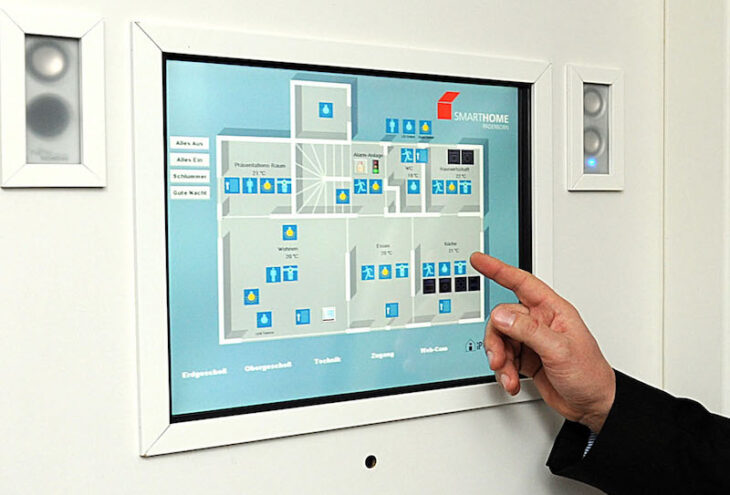Podcast: Play in new window | Embed
Tech News and Commentary
Dave and the team discuss most smarthome impressions being positive, Google allowing developers to access users’ Gmail inboxes, T-Mobile parental controls, YouTube Premium, Facebook and tbh, T-Mobile and Sprint’s merger, 3D and shopping, Morgan Stanley and subsidized Google Home Minis, and more.
Yehuda in Silver Spring, Maryland asked: “I’m looking for a 50-60 inch TV that is rated to be left on 24/7. I’ve seen some commercial monitors that are billed to support this but they run in the many thousands of dollars, where consumer TVs of that size seem to be very cheap these days. How will I know if a TV will really be able to run 24/7 for any length of time?”
Well Yehuda… TVs that can truly run 24/7 are expensive for a reason. How many hours a day would you say a typical TV needs to stay on considering that people work, go out, and generally have lives?
24/7 TVs are usually either security monitors or advertising screens, so you pay for components that won’t wear out after a couple of years of running non-stop.
You pay for components that won’t wear out after a couple of years of running non-stop.
The question here is, are you going to be running the 24/7? Or just for a big chunk of the day? Most TVs will do just fine being on for many hours a day. And the second question is, how much is the 24/7 assurance worth to you?
There’s a decent chance that if you buy any regular TV and keep it running 24/7 it will still last you many years. It may not, and they won’t promise that it will, but it will probably last you long enough that you will have amortized it by the time it breaks down and you have to replace it.
If the TV breaking down isn’t a huge problem, you may be better off with a regular one and dealing with it when it will no longer turn on, if it’s a critical component that cannot fail, then you may need to spend the money.
Andrea in Windsor, Ontario Canada listens on AM800 CKLW and asked: “I need to know how to spec out a computer to use for photography. I know it needs to have large RAM and needs to be fast. Also, I want a program for editing and filing photos, but I don’t want it to be online. And I’ve got a beautiful new printer, and Epson Tank. The higher level one. It works for everything and prints beautiful pictures but every editing program I’ve used, the colors change between whatever the computer’s telling it and what’s coming out the printer. So I need to understand how to get it to go in true color or whatever it is.”
Andrea, if you’re going to be editing large files make sure you have plenty of RAM, that doesn’t matter as much for smaller pictures you may just take on your phone, but if you’re using a professional camera and uncompressed formats having the most RAM possible will help things along. The processor is important too, like you said, but less so than it is for tasks like video editing.
As for your printer, matching colors is not trivial but the main two things you’ll need to do is calibrate your monitor and set the right color profile for your printer.
Even then, the paper your pick will have an effect too. Properly matching colors takes a good amount of work and you won’t be able to do it by adjusting as single setting and walking away. Unfortunately, this will require calibration and trial and error.
Norman in Chattanooga, Tennessee listens to the Podcast and asked: “I heard that they’re gonna need SSL certificates on all the websites even if they don’t sell stuff. Is that true or not? GoDaddy wants to charge about $60 a year for it. Don’t know if there’s a cheaper place. And I can’t understand why we’d need it if we don’t have an online store or something. I just have a bunch of “information” sites.”
Norman, you can definitely find SSL certificates for less than that. You can actually find single site certificates for free or for less than $10, some hosts offer them as part of their service.
Check out Comodo and you may find some inexpensive shared certificates. RapidSSL may be another place to look.
Of course, $60 a year is not ridiculous compared to what you probably have to pay in hosting costs for a website with traffic, so worst case scenario you may have to pay it and see it as the cost of not being penalized by Google.
Kay in Diana, Texas listens on KTBB 92.1 FM and asked: “Trying to figure out how to setup Wi-Fi service to an old farmhouse where there has never been a cable, never been a phone line and never been a telephone. I’m a little confused about that kind of technology. Whatever you have to say would be helpful.”
Kay, your options here will mostly consist of whatever service you happen to have available in the area.
Your easiest option would be to use cellphone service and get your internet and WiFi from a MiFi type of device. The problem is that you mentioned old farmhouse that has never had a phone line so the odds of it getting good cellphone service are not great.
Find out which if any companies in your area are able to provide you with internet service, you may find out that your only option is satellite. Even if you have other options, your only affordable option may still be satellite, since you may be expected to pay to wire up the distance between the ISPs nearest point of service and your farmhouse, and that could very well cost tens of thousands of dollars.
If you end up with satellite on the other hand, a dish and a cable from it to the house is all you’ll need, but because of the nature of satellite, you’ll pay a bit more for a service with slower speeds, higher latency, and probably data caps.
HughesNet, now offers a high-speed option. We’ve been using it at our studios and have actually been getting pretty decent speeds – fast enough for streaming video. However, you wouldn’t want to do that too often, as you’ll use up a lot of the data and the cost of their service does depend on how much data you plan to use. But they have very affordable plans, especially if you’re not using tons of data. You can text the word “RADIO” to 35000 and they’ll send you a link to all the information you’ll need on their service.
It’s all about what’s available in your area, start by finding that out and how much the installation to an unwired farmhouse would cost. We suspect that anything but satellite will cost a lot of money.
 When you participate on the show – anytime 24/7 – and we HEAR you with any consumer tech question, comment, help for another listener, tech rage or just share your favorite App these days … you could win prizes.
When you participate on the show – anytime 24/7 – and we HEAR you with any consumer tech question, comment, help for another listener, tech rage or just share your favorite App these days … you could win prizes.
Tablo: Tablo Dual – Whole-home Over-the air DVR for cord cutters.
Yale: Assure Touchscreen Deadbolt Lock
Bits Limited: Mini Squids — Travel-Sized surge protected power strips with 2 USB charging ports
truMedic: InstaShiatsu Head & Neck Massager
Reolink: 1080p Wire Free Battery Powered Indoor Smart Home Camera
VogDuo: aQZ 30 watt Car Charger with 2 USB-C Outlets and low voltage warning
All CALLERS — using the AUDIO option on our Free App or 1-800-899-INTO(4686) – automatically qualify to win prizes.


